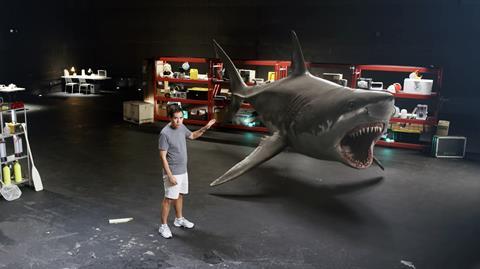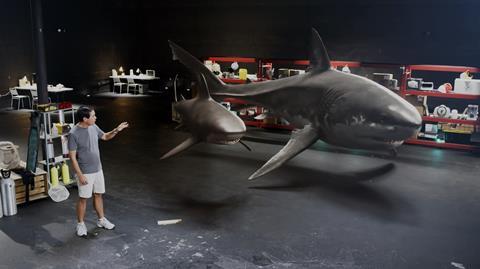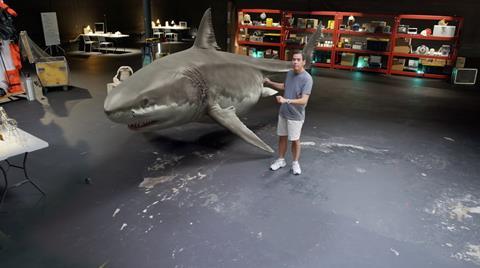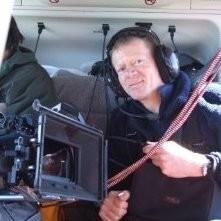Arrow Media’s Nick Metcalfe goes behind-the-scenes during the making of When Sharks Attack 360

When Arrow Media won the commission from National Geographic to make When Sharks Attack 360, a six-part series investigating the causes (and science) of shark attacks, for their Sharkfest ’23 strand, we had a lot of questions that we had to think hard about how we were going to answer.
We needed to think fast about putting flesh on the bones of our winning pitch. We already had stories of shark attacks to tell, and recreate. But it’s the next step that is the creative challenge – identifying the likely suspects, and then diving into their physiology and behaviour to reach a conclusion about why they behaved like, er, sharks.

So, we needed to see sharks. Would archive deliver the range of footage we need? Alternatively, we could choose to work with real, live sharks. In which case, where would we go? Will the sharks turn up? Will they be the right sharks? Will they behave in the ‘right’ way? Who you gonna call if they don’t turn up? Shark-busters?
Everybody knows that working with wild animals is uncertain and demanding, not to mention expensive. I’ve worked on shows where sharks just didn’t read the call sheet. Didn’t they know that we had paid top dollar to keep a crew on board a large vessel near a remote tropical paradise for weeks?
So, we came up with a different way forward.
We wouldn’t go to the sharks. We’d bring the sharks to us, virtually. That brings a whole different set of creative challenges, but also brilliant solutions.

There would be no shy sharks in our virtual 360 Shark Lab. We would have total control of the movements of life-size virtual 3D animals. We would be able to choreograph sequences so that sharks would hit their marks. They would appear in the right place, and stop on command, and the scientists could interact with them. Putting a life-size (6 metre/20 foot) great white shark next to an ordinary-sized human scientist gives a breath-taking appreciation of the scale of these apex predators.
You can sometimes see it in the wild, but not usually in a controlled way, and trust me, unless there’s a cage between you and the great white, the risk assessments and insurance paperwork are a chore. In the virtual world we would create for this series the scientists could move around the sharks and literally get under their skin – for example, finding their lateral line and showing how it detects the movements of prey.
Like old-time lion-tamers in a circus, our scientists could also put their head inside a great white’s mouth to understand how they test-taste whether they’ve bitten the right prey. Not recommended in the wild, but all completely possible, and safe, in our 360 Shark Lab. And our virtual studio would allow us to visualise the physiology that drove shark behaviour – why do juvenile great whites bite prey repeatedly? How do sharks see the world?
Surfers and divers often say that sharks are attracted to certain colours, such as ‘yum-yum yellow’. We would present ‘shark-vision’ where we literally show what sharks see. No spoilers here, so you’ll have to watch the show to know the answer, but the physiology of a shark’s eye, and what it tells us about which colours sharks can see, is an eye-opener.
All these solutions were appealing.
That just left us with the immense challenge of visualising high resolution virtual sharks in our lab. First, we had to create the raw shark-free sequences. Series producer Laura Offer worked with Weave VFX to set about storyboarding sequences for our 360 Shark Lab, which was just a Florida studio at this point. That called for extensive research and scripting to identify the sequences and what we needed to say about which sharks were in the frame – was it a bull shark, a great white, or a tiger?
Then we set about taping the plates of shark-free sequences with our experts. At this point the sharks were played by tennis balls. Armed with 4K plates, Weave had to populate the sequences with creatures with the right skin tones, and physiology and create the ambitious choreography that would present authentic behaviour and make for compelling sequences.
Working closely with world-leading experts we started with off-the-shelf models and then corrected them. We moved fins forward, we re-sculpted teeth, and changed skin tones. Then we gave our creatures their scripts and started to make the 360 Shark Lab come to life. We hope we’ve brought a new level of ambition and scientific understanding to shark shows.
And what made it especially sweet: no sharks were harmed, or even bothered, in the making of this series.
You can stream National Geographic’s When Sharks Attack 360 on Disney+ now.

Nick Metcalfe is executive producer at Arrow Media







No comments yet